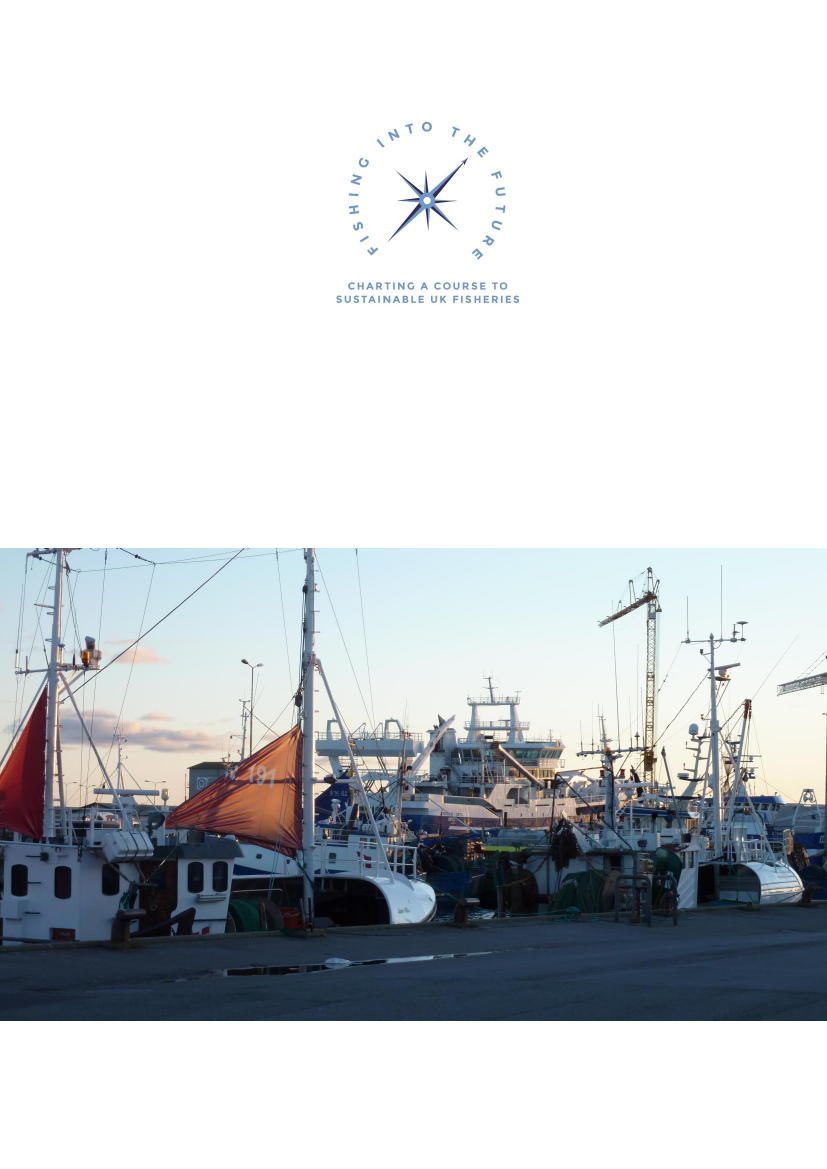Europaudvalget 2017-18
EUU Alm.del Bilag 415
Offentligt
Toward CFP implementation: Barriers and
Opportunities
Recommending options to achieve full catch accountability
Mogens Schou: Aquamind, January 2018
EUU, Alm.del - 2017-18 - Bilag 415: Kopi af MOF alm. del - bilag 275: Henvendelse af 19/2-18 fra Mogens Schou, Humlebæk, om udsmid af fisk
January 2018
Content
Executive summary
.......................................................................................................................... 3
1. Background
............................................................................................................................... 6
2. A coherent approach for fisheries management
........................................................... 6
2.1.
2.2.
2.3.
2.4.
Ensure accountability ............................................................................................................ 8
Ensure sustainability ............................................................................................................. 9
Ensure economic progress ................................................................................................. 11
The coherent approach ...................................................................................................... 12
How accountability can work ............................................................................................. 13
Remove barriers to accountability ..................................................................................... 15
Prescriptive rules ......................................................................................................... 15
Chokes and exemptions. ............................................................................................. 18
Exemptions from control measures and accessory regulation ................................. 20
Quota substitution....................................................................................................... 21
Allocation and chokes ................................................................................................. 22
TAC advice .................................................................................................................... 25
3.
Designing the policy implementation
............................................................................. 13
3.1.
3.2.
3.2.1.
3.2.2.
3.2.3.
3.2.4.
3.2.5.
3.2.6.
3.3.
The institutional issue and policy transition ...................................................................... 26
Remote Electronic Monitoring (REM) ................................................................................ 29
Introducing REM to the CFP ........................................................................................ 31
REM operation and sanctioning ................................................................................. 31
Costs of using REM ...................................................................................................... 32
4.
Documentation and accounting of catches
.................................................................. 28
4.1.
4.1.1.
4.1.2.
4.1.3.
4.2.
4.3.
Real-time, validated data for scientific advice................................................................... 33
Aligning documentation, control and certification ........................................................... 33
5. Aligning international rules
................................................................................................ 34
6. Recommendations
............................................................................................................... 35
Annex
................................................................................................................................................. 37
2
Author: Mogens Schou: Aquamind, January 2018 | contact Fishing into the Future
jim.masters2015@outlook.com
EUU, Alm.del - 2017-18 - Bilag 415: Kopi af MOF alm. del - bilag 275: Henvendelse af 19/2-18 fra Mogens Schou, Humlebæk, om udsmid af fisk
January 2018
Executive summary
Vast amounts of energy and money have been used to establish new objectives and principles for
the reformed Common Fisheries Policy (CFP), and to achieve a viable interface with the fishing
industry who must deliver these objectives.
The prime feature of the reformed CFP is the transition from unaccounted discarding (often obliged
by a flawed system) to a system where all fish count against quotas. The opportunities this creates
could be significant
–
provided
catch accountability is established:
•
•
•
The incentive to make value from each kilo of fish caught will spur sustainable behaviour;
Quotas can be increased, prescriptive regulations abandoned;
The objective of high and continuous yields (based on true, real-time data) can be met.
Much progress has been made in terms of plans, guidance, investments and assessment of
consequences from the policy. The situation at sea, however, is vastly different from what was
intended: discarding of fish continues; control is inadequate or absent; incentives for Member
States and fishermen to account for catches are weakening. Something needs to change to reverse
this situation.
The CFP
has
succeeded in curbing fishing effort and rebuild fish stocks. But, while the number of
fish stocks at or under MSY is increasing, the actual productivity of these stocks - in terms of amount
of fish generating income and food - is highly out of tune with their potential. Uncertainty and lack
of guidance are hindering fishermen from doing their best when confronted with the circumstances
at sea.
The gap between
potential
and
realised
value from fish stocks is exacerbated by:
•
•
•
•
A weak conceptual framework;
Poorly integrated/unreconcilable priorities for CFP implementation;
A complicated decision system with overlapping responsibilities;
Lack of clear direction for full and joined-up CFP implementation.
Realising the full benefits of the reformed CFP is therefore impeded not only by implementation
failure, but also by the
‘compliance
gap’ resulting from failure to control full catch accountability.
Full implementation would create a level playing field within the EU and in relation to nations with
whom EU share fish stocks.
3
Author: Mogens Schou: Aquamind, January 2018 | contact Fishing into the Future
jim.masters2015@outlook.com
EUU, Alm.del - 2017-18 - Bilag 415: Kopi af MOF alm. del - bilag 275: Henvendelse af 19/2-18 fra Mogens Schou, Humlebæk, om udsmid af fisk
January 2018
The approach for CFP implementation
This paper uses the premise of full catch accountability, twinned with results based management,
as the starting points from which to critique and propose changes to the current system of Technical
Regulations. These are entirely compatible with the intended outcomes of the reformed CFP: the
first (full catch accountability) is a clear obligation in the CFP, the second (results based
management) flows from the opportunity to manage the output of stocks directly rather than
manage the input of fishermen’s efforts and use of methods. Results-based
management has been
underlined by the responsible EU institutions as the preferred management principle of choice, but
a road-map to navigate toward this is missing. The implementing regulations now being carried
through therefore remain unclear, muddled and contradictory.
We believe that full catch accountability and results-based management must guide the
implementation of the CFP. Quota allocations, and the use of exemptions, must be based on
detailed accounts of fishing mortality: hence catch accountability and the promotion of fully
documented fisheries. This will benefit fishermen who deliver full accountability - where fully
documented fisheries are given the benefit of
output
management - while other fisheries (where
catches are not fully accounted for) will need supplementary regulation and control that takes
account of the uncertainties regarding the full mortality effect of their fishing.
In addition to managing the resource, it is necessary to develop the quota allocation system. Relative
Stability stands but there are numerous ways to improve quota transferability in order to solve
issues such as the choke species problem.
The management of our fish stocks is based on knowledge about the resource. Current data is
insufficient
–
in terms of quality and quantity - and models and processes too rigid to take account
of recent stock development or climate changes. The MSY requirement and the choke problem
accentuate the need for a reform of the advice delivered by ICES. Real-time advice must be
advanced to secure the basis for the policy.
Recommendations
Full catch accountability and results-based management must guide the implementation of the CFP.
The policy must be advanced by a programmed phasing-in of new measures. To ensure a level
playing field, REM vessels must be given the full benefit of their documentation of catches. Our
outline
recommendations are given below. Further explanation and context are given throughout
the body of this document:
4
Author: Mogens Schou: Aquamind, January 2018 | contact Fishing into the Future
jim.masters2015@outlook.com
EUU, Alm.del - 2017-18 - Bilag 415: Kopi af MOF alm. del - bilag 275: Henvendelse af 19/2-18 fra Mogens Schou, Humlebæk, om udsmid af fisk
January 2018
1. Full quota top-up for REM vessels and reduced or no top-up for non-REM vessels
2. Free choice of gear for REM vessels - except for rules related to bottom impact and by-
catches of protected species.
3. Simplified exemptions for REM vessels. The main point is that catches are recorded and
accounted for.
4. In addition to this quota exchange, solutions must be developed between and within
Member States in order to alleviate the choke species problem.
5. The present advisory system allowing TAC/Quota decisions to be made on basis of
outdated data-sampling and advisory processes is not up to par with policy commitments.
The advisory system must be reformed with regard to data sampling and production of
real-time advice.
The process
The aim of this paper is to stimulate a discussion of coherent concepts for full CFP implementation:
finding common ground on which to build policy recommendations that have broad industry buy-in
and support by illustrating a viable concept for a coherent CFP management approach that takes
account of fishermen’s interest and ability to work with the policy rather than against.
The first step on this journey is to test
“industry reaction”
to the proposals contained in this paper.
Based on this initial and narrow feedback, the project will reach out for alliance-building and
dialogue with other suitable EU and national institutions. The dialogue will cover the conceptual
framework for CFP implementation, Brexit consequences and opportunities, improvement of the
advisory system and the building of an aligned “project catalogue” that may demonstrate and
accelerate the transition to the new CFP.
The paper does not aim to cover management issues related to secondary ecosystem effects such
as bottom impact and by-catches of mammals and birds. Neither does the paper cover economic
distribution (e.g. principles for quota allocation).
5
Author: Mogens Schou: Aquamind, January 2018 | contact Fishing into the Future
jim.masters2015@outlook.com
EUU, Alm.del - 2017-18 - Bilag 415: Kopi af MOF alm. del - bilag 275: Henvendelse af 19/2-18 fra Mogens Schou, Humlebæk, om udsmid af fisk
January 2018
1. Background
Fishing into the Future (FitF) is interested in improving the contributions the fishing industry can
make to fisheries science and data collection, with a view to informing and improving fisheries
management and policy. Recent progress on this issue was made through the development of the
Guidelines for Industry Science Data Collection
–
work which was funded by Seafish in the UK.
FitF is a collaborative initiative which seeks to work in partnership with
–
and add capacity to
–
other
organisations who share similar goals and objectives. We are in the process of examining the central
paradoxes which undermine progress toward Fully Documented Fisheries (FDF) and we are being
supported in this process by
Mogens Schou
of Aquamind, alongside notable fisheries scientists,
fishermen, fisheries representatives and fisheries regulators.
This paper marks the first steps on this journey; it will describe the issues that weaken current CFP
compliance and propose workable solutions that address these. We will use this paper as a
convening tool, around which to discuss and build consensus for policy recommendations that have
the potential to succeed in terms of CFP implementation. The production of this paper is an initial
response to a call from the philanthropic funding body FundingFISH, who are looking to support
projects that tackle the barriers to achieving Fully Document Fisheries (FDF) across the board.
2. A coherent approach for fisheries
management
The concept of
‘Natural
Capital’ has gained support over recent years. It provides a new lens through
which to view the way we manage natural resources. Natural Capital can be seen in four broad
categories (World Bank):
1.
2.
3.
4.
Extractable renewable resources (capture fisheries, natural forests, soil, and water).
Cultivated renewable resources (crops, livestock, aquaculture, and forest plantations).
Non-renewable resources (oil, gas, coal, and minerals).
Ecosystems that provide regulating services (watershed management, climate regulating
services, and nature-based tourism).
Management of Natural Capital has assumed many forms in the past, depending on: the type of
natural resource; ownership; tradition; policies; technological advances. The public management of
6
Author: Mogens Schou: Aquamind, January 2018 | contact Fishing into the Future
jim.masters2015@outlook.com
EUU, Alm.del - 2017-18 - Bilag 415: Kopi af MOF alm. del - bilag 275: Henvendelse af 19/2-18 fra Mogens Schou, Humlebæk, om udsmid af fisk
January 2018
open-access (or partly open) resources has often taken the form of a combination of
“pressure
strategy” and prescriptive management. This has been,
and still is, the case in fisheries
management, where
pressure
is exerted to contain fishing effort and
prescriptive
regulations define
fishermen’s use of fishing gear.
The cost of such management
–
for public administration and the industry itself - is immense. This,
for managing a resource where the public interest is basically limited to setting the proper levels of
utilisation and ensuring that these levels are not exceeded. In 1996, C.S. Holling put the problem
like this:
“As the human population grows and natural resources decline, there is pressure to apply
increasing levels of top down, command, and control management to natural resources. Solutions
to this pathology of natural resource management cannot come from further command and control
(regulations) but must come from innovative approaches involving incentives leading to more
resilient ecosystems, more flexible agencies, more self-reliant
industries.”
From the standpoint of society, the objectives of Natural Capital, management of fisheries should
be to:
1.
Ensure accountability
Accountability is a “first”. The setting of utilization levels has little meaning if they are not
observed. Furthermore, accountability ensures a level playing field with regard to the
balance between economic results and environmental impact. Human activity often results
in unexpected negative costs that end up being paid by society or other users of the natural
resources who did
not
choose to incur these costs
(an ‘externality’).
For example, pollution
from industrial production results in costs covered by the public; and the CFP discard regime
resulted in reduced TAC’s where the reduction was paid by all fishermen
including those
with little or no discards.
2.
Ensure sustainable use
Sustainability is often understood as a principle to ensure the
protection
of natural
resources. This is misleading. Sustainability is a concept for
utilization
of resources to the
long-term benefit of mankind. The distinction is important.
“Conservation”
entails restricting
the
use of resources while “utilization” applied on basis of accountability spur optimization
of the resource.
3.
Ensure economic progress
The Brundtland definition of sustainability sees economic progress in context of fair
7
Author: Mogens Schou: Aquamind, January 2018 | contact Fishing into the Future
jim.masters2015@outlook.com
EUU, Alm.del - 2017-18 - Bilag 415: Kopi af MOF alm. del - bilag 275: Henvendelse af 19/2-18 fra Mogens Schou, Humlebæk, om udsmid af fisk
January 2018
distribution, with attention given to developing sectors. The CFP intends to contribute to
coastal economic development by including some specific social priorities.
The reformed CFP is aligned with these three objectives, but the EU has made life difficult for itself:
it has decided to reform both the
resource
and
institutional
policies at the same time, adding
confusion to an already complex process. It is remarkable that, given the need to address the
competing demands of these different types of policy, the responsible authorities have not yet
synthesised a conceptual approach for its implementation. Such a concept would be relatively
simple to establish if a clear distinction were to be made between the objectives and responsibilities
lying with the public on the one hand, and the methods applied by those exploiting the resource on
the other.
Each of the policy objectives for the management of Natural Capital
–
accountability, sustainability
and economics - are treated in more detail below.
2.1. Ensuring accountability
Full catch accountability offers immense opportunities through direct management of the output
(managing how much is taken out of the resource) compared to input management (managing input
of fishing effort, gear etc.).
The pre-reform EU management was based on a discard regime, where discards were obliged in
some situations, and incentivised in others. Unaccounted discarding took place and high discarders
taxed the resource in an uncontrolled way, thereby undermining the negotiated allocations of quota
seen in Relative Stability with catch levels above agreed catch opportunities.
From the mid-1980s onward, tackling discards gave rise to vast amounts of new rules and
regulations. Layer-by-layer these aimed at reducing fishing effort and increasing selectivity through
the implementation of prescriptive gear and other regulations. More than 20 years later the
Commission’s green paper in 2009
still saw excessive discarding as a main threat to stocks
–
the
regulations had not succeeded.
The current reformed CFP has introduced full catch accountability, thereby
potentially
allowing for
proper management of the stock. The Basic Regulation states that catches shall count against the
quotas and be landed. Whether the fish is landed or not is, however, of little biological importance:
accountability itself will incentivize fishermen not to discard fish from their quota holdings.
How does one ensure that catches at sea are actually counted against quotas? A discard ban has
existed since 2002 where high grading was banned, but with no measurable effect on discards. How
8
Author: Mogens Schou: Aquamind, January 2018 | contact Fishing into the Future
jim.masters2015@outlook.com
EUU, Alm.del - 2017-18 - Bilag 415: Kopi af MOF alm. del - bilag 275: Henvendelse af 19/2-18 fra Mogens Schou, Humlebæk, om udsmid af fisk
January 2018
can the full discard ban, now including even less valuable fish, be expected to meet compliance?
The answer is that compliance cannot be expected if neither incentives nor control are put in place.
The Commission and Member States (MS) have made considerable efforts to guide and inform
fishermen about discards, but they have done little or nothing to control or incentivize fishermen to
count and land the fish they catch. Accountability has therefore
not
yet been established
–
and none
of the potential benefits are being seen.
Counting all catches is also the prerequisite for accurate management of fish stocks. The CFP is
based on TAC/quotas being set and managed to ensure Maximum Sustainable Yield (MSY). It seems
obvious that we can’t manage what we don’t
measure; hence accountability is the decisive element
for the MSY policy.
Note:
In this paper accountability is understood as the counting of all catches - or fishing mortality,
against quota holdings and the documentations of this being done.
2.2. Ensure sustainability
Fish stocks in EU waters are improving. Fishing effort and fishing mortality has gone down and more
and more stocks are, by definition,
“fished
sustainably”.
The MSY objective in the CFP focuses on a speedy increase to the level of MSY for individual stocks:
“The
CFP shall aim to ensure that exploitation of resources restores and maintains populations of
harvested species above levels which can produce the maximum sustainable yield by 2015 where
possible and
at the latest by 2020 for all stocks”
(excerpt 1380/2013).
This MSY objective is based on a 1
st
generation approach that ignores ecosystem functioning in
terms of stock dynamics and species interactions.
Analyses
indicate an order of 40% less yield than
by applying an ecosystem based MSY approach. It also ignores
fishermen’s ability to target individual
species in mixed fisheries and thus catch the given fishing opportunities.
The Basic Regulation preamble states that:
Management decisions relating to maximum sustainable
yield in mixed fisheries should take into account the difficulty of fishing all stocks in a mixed fishery
at maximum sustainable
yield at the same time”,
and the Multi Annual Plans (MAPs) have
introduced fishing mortality ranges. This offers some help but fails to explain how the reform will
transform from a policy to
protect
the resources into a policy gaining the highest
sustained output
of food from the resource. For the many fish stocks in good shape the important challenge is not to
manage TAC levels, but to ensure that the levels set are respected, and to ensure that the fish can
actually be caught without colliding with irrelevant regulatory boundaries.
9
Author: Mogens Schou: Aquamind, January 2018 | contact Fishing into the Future
jim.masters2015@outlook.com
EUU, Alm.del - 2017-18 - Bilag 415: Kopi af MOF alm. del - bilag 275: Henvendelse af 19/2-18 fra Mogens Schou, Humlebæk, om udsmid af fisk
January 2018
It is a collective failing that so much political capital has been invested - by the political system and
NGO’s
- in the setting of the MSY target and subsequent attempts to
oblige the system to “follow
scientific advice”
on one hand, whilst so little effort has been focused on improving the scientific
advice that is needed to bring this about.
This paper does not expand on the “science failure” but it
is noted:
•
•
•
•
•
That a number of Member States fail to supply data - or even obstruct data exchange.
That protocols for the inclusion of fishermen’s data in advice has not been developed,
despite some fully documented fisheries supplying data for a number of years.
That advice is normally based on data that can be 1�½-2 years old, and fails to include reliable
up-to date information on recruiting year classes - or changes in model references.
That modelling of advice is based on static approaches and on single species thinking in terms
of both trophic and economic context.
That EU as a client and ICES as a science provider have failed to assess and include new
methods to advance advice to information in real-time.
In 2013
SCAR-Fish advised:
“The reformed
CFP requires more data and more areas to be covered by
data. Also the discard ban and the resulting “choke species” issue require better advice in terms of
analytical and real-time qualities and with regard to manageable options when choosing MSY
solutions.”
In the thinking of this paper, a sustainable utilisation of the natural capital (i.e. fish) starts with a
comprehensive and accurate real-time knowledge about the size, distribution and likely
development of the stock.
The second step is to define a policy for the utilisation of the stocks that allows for a high continuous
catch from each stock. This policy must take account of two facts, a) not all stocks can produce
maximum yield (MSY) at the same time because of predation interrelationship and b) not all stocks
can be fished at MSY because catch composition in mixed fisheries do not necessarily reflect the
composition of TAC’s.
Projects as
FMSY
and
MyFish
may provide CFP legislators with an adequate and perceptive MSY text
as they aim to bridge the gap between science and advice.
10
Author: Mogens Schou: Aquamind, January 2018 | contact Fishing into the Future
jim.masters2015@outlook.com
EUU, Alm.del - 2017-18 - Bilag 415: Kopi af MOF alm. del - bilag 275: Henvendelse af 19/2-18 fra Mogens Schou, Humlebæk, om udsmid af fisk
January 2018
2.3. Ensure economic progress
This paper is based on the notion that management should be decentralised to the lowest
appropriate level to obtain effectiveness and equity, ensuring decisions and management are
pertinent and relevant to the fishing and social interests directly involved. Furthermore, leaving
management decisions with the industry will establish a user-driven demand for science and
innovation. Accountability and results-based management will put the correct drivers for CFP
implementation in place. This will not, however, solve the problem of choke species overnight.
EU-level economic progress depends on policy decisions being tailored to the varying ecosystems in
Community waters. For example, applying MSY, exemptions and the fleet-composition all differ
between single species fisheries such as those seen in the Baltic, to the highly multispecies fisheries
of the Mediterranean. The pressure put on fishermen to oblige with the ideal TAC/quota
perception of all fish being caught in a 100 % selective fishery must take account of this. Projects
such as MyFish and DiscardLess have been initiated to support this development, but there seems
to be a lack of policy inclusion.
It is worth noting at this point that no work has yet been done to understand the impact and
distribution of externality costs
(i.e. costs being born by those who didn’t choose
to incur them)
caused by the former discard regime.
Economic progress at the Member State level depends on the resources being allocated to the most
efficient user. Other priorities are also enshrined with the CFP. This paper notes that small scale
fisheries (SSF) are valued by other factors and that Relative Stability is an allocation matrix that
stands. However, despite these constraints, untapped opportunities exist: Transferable Fishing
Concessions (TFCs) allow for better catch distribution, help alleviate the choke problem and may
benefit SSF.
The ability of the fisher to match his catches with his quotas holds a substantial economic gain. This
depends on a portfolio of solutions playing together. This is discussed in Chapter 3.
11
Author: Mogens Schou: Aquamind, January 2018 | contact Fishing into the Future
jim.masters2015@outlook.com
EUU, Alm.del - 2017-18 - Bilag 415: Kopi af MOF alm. del - bilag 275: Henvendelse af 19/2-18 fra Mogens Schou, Humlebæk, om udsmid af fisk
January 2018
2.4. The coherent approach
A coherent approach to the problems posed by implementing the CFP can be achieved if the
relevant authorities are clear about objectives and their priority. This translates in to: a) applying
accountability and MSY in context of sea basin ecosystems and b) prepare for a revised MSY
approach.
1.
Be clear about strategy:
Improve the knowledge base through innovative data sampling and
real-time advice. Release the forces of ingenuity in industry and science through results-
based management. Establish first mover opportunities to demonstrate and accelerate
implementation.
2.
Be clear about coherence:
Ensure implementing rules support
–
not obstruct - objectives
and strategy.
3.
Be clear about responsibilities and process:
The Commission must take responsibility for
progress and compliance, and the Commission must put pressure on Member States to act
on their responsibilities.
This may sound straightforward, but various barriers stand in the way of putting the policy into
operation. These are discussed in the following chapters.
12
Author: Mogens Schou: Aquamind, January 2018 | contact Fishing into the Future
jim.masters2015@outlook.com
EUU, Alm.del - 2017-18 - Bilag 415: Kopi af MOF alm. del - bilag 275: Henvendelse af 19/2-18 fra Mogens Schou, Humlebæk, om udsmid af fisk
January 2018
3. Designing policy implementation: addressing
barriers
This paper considers full catch accountability as the primary prerequisite and driver for the
sustainable practises that will underpin the CFP objectives, and lead to the best possible economic
result from a complex resource base. For that reason, it is essential to address the barriers to full
catch accountability. Such barriers are a result of ecosystem characteristics, the regulatory system,
and they are also inherent in the fleets and fisheries that have developed under the pre-reform
CFP.
3.1. How accountability can work
The CFP principle of full catch accountability entails that the yearly EU TAC/quotas are fixed without
deductions for discards. The chosen total fishing mortality is translated directly into the TAC and
resulting Member State (MS) quotas.
This means fishermen pay from their quota holding for each kilo fish he catches. Ideally this is
documented for each individual vessel through a reliable system such as Remote Electronic
Monitoring (REM).
For many vessels REM is not an immediate solution. In this case accountability can be achieved by
reserving a certain percentage of the TAC, and resulting national quotas,
in an “accountability pool”
to cover unaccounted catches. If an individual Member State can demonstrate that the unaccounted
catches for certain fleets are lower than the estimate, they may access part of the MS pool for these
fleets. If the Member State chose to mount REM on every vessel it will be allowed to fish its entire
pool while the Member State choosing not to do anything will get no access to the pool.
The effect of the approach is:
•
•
•
•
Reversal of the burden of proof: Member States will have to demonstrate an accountability
scheme in order to get access to the national
“accountability
pool”
An incentive to use REM.
A reduction of externality costs for Member States who wish to distinguish between fleets
when applying for access to the accountability pool.
Incentivising selective fishing and monitoring in order to improve the statistical
documentation of reduced discards for fleets not using REM.
13
Author: Mogens Schou: Aquamind, January 2018 | contact Fishing into the Future
jim.masters2015@outlook.com
EUU, Alm.del - 2017-18 - Bilag 415: Kopi af MOF alm. del - bilag 275: Henvendelse af 19/2-18 fra Mogens Schou, Humlebæk, om udsmid af fisk
January 2018
The approach is closely aligned with the CFP. In effect no viable alternative has been pointed out.
Article 15 (1380/2013) requires all catches to be counted against quotas and article 33.5
(1224/2009) requires that all catches shall be charged against the quotas applicable to the Member
State.
The PECH Committee
research paper
on MSY discussed the model in 2016:
“under
catch quotas
(landings plus discards) implementation error is avoided, but only if all catches of quota species are
accounted for. Full catch accountability can be achieved by observers or remote electronic
monitoring, i.e. fully documented fishery (FDF). A fisheries management could be improved by a
quid-pro-quo or tiered approach, when groups of fishers (or Member States) deploying FDF are
entitled to catch their full quota shares, whereas groups of fishers (or Member States) without FDF
would be assumed to discard; these assumed discards would be subtracted from their quota share.
The obligation to account for all catches lies with each individual fisherman, as well as the Member
State. As Commissioner Vella stated (European Parliament question E-000088/2015):
“If
the
Commission finds that the quota available to Member State has been exhausted, the fishing activities
for the stocks concerned are prohibited. If a Member State has exceeded the allocated quota, the
Commission can make deductions from future quotas in accordance with the rules of the Control
Regulation.”
If the Commission finds that registered catches plus estimated discards exceed the agreed catch
levels, the Commission is obliged to consider the pay-back scheme (art 105, Reg. 1224/2009).
The conclusion is that accountability can be established as a practical and simple management
measure and it does not require REM for all vessels.
Accountability pools can be introduced for selected stocks in the 2019 TAC/quota regulation. The
pool ensures accountability, it offers an incentive to document catches and fish selectively and it
does not impose mandatory obligations for Member States or fishermen.
The model is illustrated in annex 1.
14
Author: Mogens Schou: Aquamind, January 2018 | contact Fishing into the Future
jim.masters2015@outlook.com
EUU, Alm.del - 2017-18 - Bilag 415: Kopi af MOF alm. del - bilag 275: Henvendelse af 19/2-18 fra Mogens Schou, Humlebæk, om udsmid af fisk
January 2018
3.2. Removing barriers to accountability
Full catch accountability rules. We face a transition, however, that poses sizeable challenges for the
industry. The success of implementation depends on the regulatory set-up and solutions to
facilitate the transition. This is not presently the case.
The CFP is not a coherent system of legislation. The reformed Basic Regulation is a patchwork of
principles, sometimes inconsistent; and detailed prescriptive rules, sometimes contradicting.
Implementing regulations such as technical rules and control have not yet been adapted to the new
policy, and discussions of the possible adaptations shows that legislators have little faith in the main
pillar of the reform: That all catches will be counted. Therefore, the transition from prescriptive
management to results-based management is blurred by lack of faith in, and understanding of, the
principle of full catch accountability. When viewed alongside direct obstruction to the agreed
reform and negligence of its enforcement, these are the main political barriers threatening full catch
accountability.
For the fisherman, the main barrier to assume accountability is loss of income. This problem is
caused by:
1.
2.
3.
4.
Adverse regulation.
Chokes, ecosystem characteristics and exemptions not properly used.
Rigid allocation of fishing opportunities.
Low adaptability in some fleets and fishing practises.
3.2.1. Prescriptive rules
Management of fish stocks is conceptually simple: To catch the maximum amount of fish that a
stock can provide year after year in such a way that lets juveniles grow to value before they are
caught. In the reformed CFP, the first is obtained by MSY and the transition to full catch
accountability - catch quotas instead of landing quotas. This leaves the issue of size composition in
catches. Up to now the CFP has promoted
a very simple size paradigm: “Fish
only the largest fish”.
Through technical regulations, gear rules, by-catch rules etc.
the policy level has guided fishermen’s
activity at sea in detail. Selective harvesting is complex, and it has become clear that the distance
between prescriptive regulations and the
fisher’s
appreciation of the situation at sea is causing
unacceptable waste of resources and poor economic returns.
To achieve optimal utilization of the resource the fisherman should be able to choose how to fish,
according to the variability of the circumstances at sea. User-driven innovation would then take the
lead in developing selective fishing methods. For that reason, free choice of gear must be the guiding
15
Author: Mogens Schou: Aquamind, January 2018 | contact Fishing into the Future
jim.masters2015@outlook.com
EUU, Alm.del - 2017-18 - Bilag 415: Kopi af MOF alm. del - bilag 275: Henvendelse af 19/2-18 fra Mogens Schou, Humlebæk, om udsmid af fisk
January 2018
principle - except for regulation to protect sea-bed and habitats. This allows fishermen to deal with
the choke issue on their own terms. Full catch accountability already applies; the question is what
the effect will be in relation to size composition, and to what extent it should be managed.
The answer is to introduce catch metrics. Technical rules are an indirect way of managing the fishing
mortality; catch metrics
remove
the need for detailed technical rules. Focus lies instead on size
composition of catches rather than on the gear and the fishing method. Catch metrics define an
output
result, for instance a given proportion of the catch below Minimum Conservation Reference
Size (MCRS).
Catch metrics already apply in the advice given by ICES when targeted mortality is translated into
advice in tonnes. If the average age/size of the fish in a stock decrease over time, ICES will reduce
the TAC advice to counteract an increasing mortality.
The use of catch metrics at EU and Member State level will depend on the fisheries in question. A
simple approach is to require a maximum percentage (e.g. 10%) of the catches to be below MCRS.
Another more precise tool is to set a maximum fishing mortality that Member States' catches may
induce on the stock. With a maximum fishing mortality, the Member States may distribute the
mortality according to national priorities by allowing some fisheries to include smaller specimens -
for example in mixed fisheries - on condition that catches count with a factor higher than 1. This can
be done via the market size norms.
In single species fisheries, such as cod, where the big fish are relatively valuable, there is no need to
take catch metrics on-board. Free choice of gear is likely to reduce mortality on its own, and
Trials
suggest that this occurs. Even in fisheries where free choice of gear may incentivise catches of
smaller fish there is no need to use
‘belt
and braces’ when catch metrics are employed. REM and
the standard provision to sort fish according to size will ensure a real time picture of fishing mortality
and size distribution in the various types of fisheries.
In single species fisheries where price-relations do not favour big fish, it could be argued that it is
acceptable to allow smaller fish to be caught (at a lower TAC) with the same, or even an increased,
economic turn-over. This paper does not discuss Balanced Harvesting, but note that catch metrics
can serve a variety of harvesting strategies. The sanction - or pay-back, would be to reduce quotas
for the subsequent year for a Member State exceeding either the TAC or the mortality ceiling. This
tool is in the Control Regulation. If Member States, nationally or on a regional level, wish to
introduce gear regulations to influence mortality, they may do so.
16
Author: Mogens Schou: Aquamind, January 2018 | contact Fishing into the Future
jim.masters2015@outlook.com
EUU, Alm.del - 2017-18 - Bilag 415: Kopi af MOF alm. del - bilag 275: Henvendelse af 19/2-18 fra Mogens Schou, Humlebæk, om udsmid af fisk
January 2018
The
‘catch
metric’ approach allows for:
•
•
•
free choice of gear,
tailoring catch accounting to the individual fisheries metiér
tailoring catch accounting to the changes in species and size composition (for example in
situations with large recruiting year classes).
This makes the vast number of provisions regarding gear type and use superfluous, and it allows for
externality costs to be neutralized.
The use of catch metrics is in accordance with the reformed CFP. It is in effect a logic consequence
of full accountability,
which is a “what you catch” output management,
as opposed to the previous
“how you catch”
input management.
Catch metrics will incentivise the fisher to continuously optimise methods and gear, and science will
benefit from fishermen being new ‘customers’.
Catch metrics with REM makes the ban on selling
fish under MCRS for consumption superfluous. The hinge factor for this management to work is full
catch accountability as defined in article 15 (1380/2013), including the use of REM covering a
substantial part of catches.
A revision of the Technical Regulations is currently being considered in the European Parliament and
Council. The Commission proposal indicates important simplifications of the regulatory framework,
but the principle of top-down management is retained. The Parliament however has proposed a
significant
amendment
(art 17 and 26) regarding:
•
•
Fishing vessels with full documentation of catches and discards shall not be required to land
non-marketable catches, provided that they are counted against quotas.
Pilot projects that explore and develop systems of full documentation of catches and
discards based on measurable targets and objectives, for the purpose of a results-based
management of fisheries. The projects may derogate from technical measures.
The Commission shall define the technical specifications of a system for the full
documentation of catches and discards.
•
The amendments show that the Parliament is taking full catch accountability, free choice of gear
and catch metrics on-board with the purpose of exploring the opportunities for a results-based
implementation of the CFP.
17
Author: Mogens Schou: Aquamind, January 2018 | contact Fishing into the Future
jim.masters2015@outlook.com
EUU, Alm.del - 2017-18 - Bilag 415: Kopi af MOF alm. del - bilag 275: Henvendelse af 19/2-18 fra Mogens Schou, Humlebæk, om udsmid af fisk
January 2018
3.2.2. Chokes and exemptions.
The CFP includes various exemptions to alleviate the choke species problem. The term
‘exemption’
is somewhat misleading, as several of the tools qualify as a natural and integrated mechanism for
the industry to interface with a complex resource. These management tools should therefore be
broadened as much as possible in respect of the overarching principle of full accountability. The
tools should also incentivise innovation in fisheries, as fleet structure and fishing methods will have
to adapt to the changed playing field. This change should be driven by the economic interests of the
industry.
Inter-species flexibility
This provision allows catches that are either a) caught in excess of quotas or b) catches of species of
which the Member State has no quota, to be deducted from the quota of the target species. The
rule goes against the accountability principle and it entails a double book-keeping where authorities
count catches against the quota for one species and biologists count against another species. The
use
of the rule will imply that fishermen gain an incentive to “fill-up” with non-quota
catches even
if the need is not there.
Rather than accepting non-quota catches, such occurrences should be dealt with under de-minimis,
or in an amendment to article 105 in the Control Regulation (1224/2009). The pay-back should then
take effect as in Commission Reg.
2017/2309.
This however does not remove the problem which in
many cases relates to quota allocation mechanisms. This is discussed in chapter 3.2.5.
De minimis
Up to 5% of the annual catches can be exempt from the landings obligation. This provision applies
i.a. when selectivity is difficult to achieve and there are provisions for the documentation of catches.
Catches under the provision shall not be counted against the relevant quotas; however, all catches
shall be fully recorded.
Taking into account the ongoing high levels of discards, and the transitional problems moving to full
catch accountability, this paper considers the de minimis rule as helpful in choke situations. It should
apply for REM vessels only in order to ensure documentation of the recording.
Catches being recorded - but not counted - against individual quotas respect the need for correct
data for advice. Subsequent TAC/quotas
will be reduced and the “cost”
thus paid by all fishermen
with quota access.
18
Author: Mogens Schou: Aquamind, January 2018 | contact Fishing into the Future
jim.masters2015@outlook.com
EUU, Alm.del - 2017-18 - Bilag 415: Kopi af MOF alm. del - bilag 275: Henvendelse af 19/2-18 fra Mogens Schou, Humlebæk, om udsmid af fisk
January 2018
Year-to-year flexibility
‘Year-to-year
flexibility’ does not seem a strong tool to resolve choke situations. It is useful in the
sense that it departs from
the “use it or lose it”
approach, and it could be explored further in context
of Multi Annual Plans, a real-time based advisory system and a more continuous management than
the present calendar year approach offers.
High survivors
The landing obligation does not apply to species for which scientific evidence demonstrates high
survival rates. Determining what counts as a high survival rate poses a challenge to scientists due to
the high level of variability in the survival rate, reflecting ever-changing conditions (fishing gear,
trawling-time, season, age, treatment on deck etc.).
STECF
stated: ”Survivability – a huge debate”.
This has led to both a decision stale-mate and some non-controllable rules such as time-length,
depth of towing and requirement of immediate release. This problem can, however, be properly
addressed on the basis of the mind-set inherent in the CFP, which allows costs and benefits from
discarding to be internalised in the catch quota management.
The solution is to provide an exemption for species considered to be sufficiently capable of survival.
The exemption then applies as follows:
1. Releasing is allowed for fish under MCRS.
2. Released catches count on the vessel quota with a percentage of the catch that reflects
expected average mortality for the given species.
3. Vessels with REM can use the exemption.
This approach will ensure that fishermen are accountable for the mortality they inflict on the stock,
and, more importantly, they have the incentive to minimise unwanted catches and discards thereof.
In effect this approach is robust enough to allow for free discarding of fish under MCRS, which
underpinned the large-scale Danish REM trials for 8 years.
The approach entails that catch of a species with an average survivability of 40% will count 60%
against the fisher’s quota holding.
Setting the survivability (and hence the catch account) allows for
some useful modifications. For low level stocks the account can be set at a precautionarily high level.
On the other hand, for a sound stock such as plaice where the phasing-out of discards in the
sole/plaice fishery is difficult, it is possible to set a relatively low account percentage provided the
actual catches are recorded. The resulting next-years TAC reduction will then be paid by all
fishermen, including low-discarders. In the long run,
letting the “next fisher” pay
is not viable. The
long-term answer to the problem is to innovate methods that compare with best practises, or suffer
the economic extinction of the fleet.
19
Author: Mogens Schou: Aquamind, January 2018 | contact Fishing into the Future
jim.masters2015@outlook.com
EUU, Alm.del - 2017-18 - Bilag 415: Kopi af MOF alm. del - bilag 275: Henvendelse af 19/2-18 fra Mogens Schou, Humlebæk, om udsmid af fisk
January 2018
Low-volume chokes
The ecosystem poses difficult choke problems for low-volume and protected species. A lot is done
to develop technical solutions, but it is also necessary to consider management of these species in
respect of the various sea basin characteristics. In this paper, low-volume species are defined as
species that will choke even with an optimal allocation between all fisheries irrespective of
nationality. This includes protected species. Special tools should be considered for low-volume
species where transferability tools have been used to the full extent. With this condition the
following tools should be applied in order to underpin accountability:
1.
For quota regulated stocks
the TAC should be fixed at a level that takes account of the
mixed fishery and which is above the precautionary approach (art. 2.2. 1380/2013). Discard
exemptions may apply depending on species survivability. The count against quotas is set on
a precautionary high level, and it may be differentiated according to fishing method and
best practise documented through REM.
2.
For non-quota stocks
not under analytical assessment, it is necessary to establish reference
points and trigger indicators with regard to acceptable fishing mortality. It is not advisable to
manage these stocks within an “others”
category, as it may result in overfishing of individual
species. Discard exemptions as under point 1.
3.
For protected species
it is advisable to define a catch or reference limit, to oblige all catches
to be released, to record all catches and to count these against the limit with a suitable factor
reflecting survival for the species in question.
This approach will ensure a given level of protection of the species, it will ensure accountability, it
will maximise economic output in mixed fisheries, and it will stretch the quota holdings through a
properly defined discard exemption.
The exemptions and flexibilities in the Basic Regulation have been discussed in various fora; a.o. in
the NSAC
report
of October 2017.
3.2.3. Exemptions from control measures and accessory regulation
The Control Regulation and a number of control provisions in other regulations are developed
before the reformed CFP. REM offers a full and continuous documentation of all important control
aspects. The REM solution should be integrated with the upcoming revision of the Control
20
Author: Mogens Schou: Aquamind, January 2018 | contact Fishing into the Future
jim.masters2015@outlook.com
EUU, Alm.del - 2017-18 - Bilag 415: Kopi af MOF alm. del - bilag 275: Henvendelse af 19/2-18 fra Mogens Schou, Humlebæk, om udsmid af fisk
January 2018
Regulation and REM vessels should be exempted from a number of control provisions such as
stowing and notification of gear, restricted landings to designated ports, prior notification rules etc.
Management and control of fleet tonnage and engine power saw the light with the MAGPs
(Multiannual Guidance Programmes) in the mid-eighties. The aim of the programmes was to curb
overcapacity, excess fishing effort and mortality. This link between overcapacity and excess fishing
mortality will cease to exist with full catch accountability and the regulation of capacity should
exempt fleet segments covered by REM.
3.2.4. Quota substitution
ICES
present
mixed-fisheries projections in terms of catch for a number of demersal stocks. For
stocks where
the FMSY range is available, a “range” scenario is presented that minimizes the
potential for TAC mismatches. This scenario returns a fishing mortality by stock which, if used for
setting single-stock fishing opportunities, may reduce the gap between the most and the least
restrictive TACs, thus reducing the potential for chokes.
However, this
is not a great help as the TAC’s are split into Member State quotas
according to
Relative Stability, which does not reflect composition in catches. The range approach would benefit
from being included: not only in the TAC but in the resulting Member State quotas as well.
A model could look as follows:
•
•
•
•
A reference TAC based on ICES choke-reducing mortality is set for each relevant stock.
The upper TAC level is indicated for each stock on a single stock basis.
These levels are reflected in the Member State quotas.
Each Member state may choose a quota portfolio with quotas at the upper level and with a
total value (for example in cod equivalents) that aligns with the reference value.
This ensures that the single species management concept is retained, but quota flexibility is
increased. The approach can be modulated on the basis of trophic interrelationships between
species; given the scientific basis is developed.
An obvious
alternative is to set all TAC’s at the upper level and accept that some Member States will
not be able to utilise their catch opportunities. The resulting incentive to discard non-quota catches
will have to be contained through REM. This would be a de facto change of Relative Stability. The
best
alternative is to set all TAC’s at the upper level and calculate
a value-balanced in-year quota
exchange between Member States that minimises the choke effect for each year. The modalities
21
Author: Mogens Schou: Aquamind, January 2018 | contact Fishing into the Future
jim.masters2015@outlook.com
EUU, Alm.del - 2017-18 - Bilag 415: Kopi af MOF alm. del - bilag 275: Henvendelse af 19/2-18 fra Mogens Schou, Humlebæk, om udsmid af fisk
January 2018
for such a quota exchange agreement would have to be established by Member States in a Relative
Stability compliant way under the swap system (art. 16. 1380/2013).
3.2.5. Allocation and chokes
Transferable Fishing Concessions (TFC) may be seen in context of permanent fleet adaptation or
day-to-day matching of catches with quota holdings. The first entails the transfer of permanent
rights, typically in the form of a given share of a national quota. The second type of transfer is an in-
year leasing - or swapping; there are no changes in share ownership.
TFCs are a contentious management tool. Discussions should focus on the ability of TFC designs to
meet defined objectives, and to assess the dynamic consequences associated with that. Our
Western economy is a market-based, where half of the turn-over is spent on policy prioritised areas.
TFCs can produce wealth
and
be managed to deliver to socioeconomics at the same time. This
paper, however, focuses on in-year transferability as a means to contain chokes. The considerations
are equally valid in relation to climate-migration of stocks.
3.2.5.1
Transferability within EU Member States
Member States have wide opportunities to establish transferability, illustrated by the following:
a. Producer Organisations & cooperatives
PO’s are managing fishing allocations in some Member States. The flexibility with regard to matching
catches with quotas depends on the individual PO. While the system limits the freedom of the
individual fisher, it may prevent fishermen from establishing a
‘corner
of the market’ of sensible
choke species. A number of Member States employ variants of the PO-pool under the Common
Market Regulation (CMO). Some fishermen have established coop-pools outside the CMO.
b. TFC-pools
This type is
a lease/swap “home-banking system” that allows
individual fishermen to swap and lease
quota according to his own choice, and depending on the demand-supply situation. Danish TFC
pools are managed by the industry. The Fisheries Agency sees each pool as
“one vessel” in the sense
that vessels are allowed to overfish their individual quotas as long as the pool total is not exceeded.
This allows fishermen to land and sell fish without having a quota and retrospectively lease-in the
amount needed. The system does not have a formalised protection against speculation in chokes,
but, as with a fisherman-managed system, social pressure may apply.
c. Risk-pools
22
Author: Mogens Schou: Aquamind, January 2018 | contact Fishing into the Future
jim.masters2015@outlook.com
EUU, Alm.del - 2017-18 - Bilag 415: Kopi af MOF alm. del - bilag 275: Henvendelse af 19/2-18 fra Mogens Schou, Humlebæk, om udsmid af fisk
January 2018
Risk pools are used in USA. Here fishermen combine their quotas of overfished species and chokes
to reduce the risk for the individual fisher. Members of the pool who catch the relevant species are
covered by the pool. The condition for participating in the pool is that spatial fishing plans are
adhered to. These plans are updated by the fishermen for example through
eCatch:
“Knowing
where
by-catch events occur is one way to avoid problems. eCatch gives captains an easy way to capture the location
of their by-catch events, visualize them on a map, and share with other members of their local community.
eCatch operates on a “give get” principle, meaning if you choose to share your by-catch
locations you will
receive a generalized map of by-catch from other eCatch users in your fishery.”
Sharing of knowledge and by-catch avoidance tactics is relevant, even if sharing of quotas is not
involved. Spatial management may be developed in order to direct fishing effort in the increasingly
dynamic ecosystem. Spatial management, including real-time closures and precautionary areas,
should be considered as a tool to inform fishermen’s decisions rather than
obliging them through a
new layer of regulations.
An example of this is the
pilot project
in the Bristol Channel, which is providing daily reports of
spurdog by-catch, using a grid reference system. An REM system, supplemented by vision software,
may further qualify conditions regarding by-catches and automatize sharing of information in real-
time.
Practical innovation needed
The design of a pool may well combine elements from the various types mentioned above. Member
States and fishermen should not hesitate to discuss pool objectives and design elements. The basic
design must be based on sea basin characteristics, fisheries (métiers), level and type of fisher-
organisation etc. Technological innovations and developments will also offer new opportunities. In
some years, blockchains may automatically show the optimal real-time distribution of quota
holdings in defined systems and allow for rule-based, or personal, transactions in a peer-to-peer
industry-wide network, operating within appropriate national boundaries.
3.2.5.2 Transferability between EU Member States
Member States may, after notifying the Commission, exchange all or part of the fishing
opportunities allocated to them (Art 16.8 1380/2013). Even though this provision is widely used
already, the options for more advanced uses have not been explored.
In general, Member States have been reluctant to consider swaps beyond the bilateral 1:1 model,
where the quota exchange between the two Member States is in balance with regard to amount or
value. More effort should be done in order to establish flexibilities with regard to transferring quota.
Another major problem appears to be the reluctance to open a discussion on Relative Stability
23
Author: Mogens Schou: Aquamind, January 2018 | contact Fishing into the Future
jim.masters2015@outlook.com
EUU, Alm.del - 2017-18 - Bilag 415: Kopi af MOF alm. del - bilag 275: Henvendelse af 19/2-18 fra Mogens Schou, Humlebæk, om udsmid af fisk
January 2018
between Member States. Allocation of quotas between groups or individuals at the National level
(National quota management) may also hinder transnational swapping. A technical evaluation of
various models might facilitate new solutions; for example the ones floated here:
a. Roll-over arrangements between Member States
Member States may, on bi- or multilateral bases, establish swapping arrangements that even out
imbalances due to Relative Stability. The swap could be concluded every year following the
December TAC/quota decisions. This solution has already been in use.
b. EU buffer
The
‘inter-species
exemption’ is an example of a negative impact of a regulation (however
unintended), which is used in situations where the Member State has no quota for a choke species.
The problems associated with this could be alleviated through swaps or even unilateral transfers. A
buffer could be set aside at the EU-wide level in the yearly TAC/quota regulation for the relevant
stocks, which is then used to cover non-quota catches. Such catches should
still
be discouraged,
however, through an amended article 105 (1224/2009) as this buffer would only be used in extreme
circumstances. Alternatively, and in full respect of Relative Stability, the buffer may be used as a
basis for continued exploitation of the target species, while the choke species itself is counted
against the buffer and discarded.
The buffer would incentivise Member States to solve the problem between themselves before a
buffer is established.
c. Unilateral transfers
In some areas, Member States have choke issues on high volume stocks on which they do not have
a quota. The direct consequence of this is unaccounted catches and discards. As long as this failure
goes uncorrected, it will block proper documentation of catches. Member States that
do
have
sufficient quota of the stock in question may offer a quota transfer for free, on the condition that
all catches are accounted for, with suitable controls applied using REM where appropriate. Transfers
lower than the level of unaccounted catches would benefit all players, as unwanted catches would
cease to tax the TAC.
d. Transnational pools on Member State level
Member States spend considerable time on bilateral talks regarding possible swaps. Instead, they
could announce their
‘demand-supply’
profile on a common webpage in order to create
transparency as a basis for swaps. The pool may be served by an algorithm that suggests more
24
Author: Mogens Schou: Aquamind, January 2018 | contact Fishing into the Future
jim.masters2015@outlook.com
EUU, Alm.del - 2017-18 - Bilag 415: Kopi af MOF alm. del - bilag 275: Henvendelse af 19/2-18 fra Mogens Schou, Humlebæk, om udsmid af fisk
January 2018
complicated swaps involving several Member States. The model could be considered to cover 3
rd
countries such as Norway and UK after Brexit. Relative Stability would then be an issue.
e. Transnational pools at the individual fisherman level
It is possible to establish a transnational pool, where leasing and swapping of in-year quotas takes
place between individual fishermen, or their POs, in full recognition of Relative Stability and the
Member State prerogative to manage national quotas.
The outline is that:
•
The Member State wishing to participate at the beginning of every quota year decides the
acceptable quota share that may be leased out by their individual fishermen, or PO’s, and for
the stocks chosen by the Member State.
The quota boundaries for the Article 16 swap is registered with the Commission and each
realised swap is subsequently registered.
The MS may allow free leasing within the quota limits and other conditions (such as
maintaining a pre-defined value balance).
A technical facility is established to manage the pool. A web based facility allowing for relevant
boundaries to be attached to the individual fisher or PO participating in the system will
function like a home banking system. Such a
system
is in operation.
•
•
•
This may need a flexible interpretation of art. 16 (1380/2013).
3.2.5.3.
Transferability with third countries
The CFP aims to ensure sustainable exploitation of stocks shared with third countries through a.o.
the exchange of fishing opportunities (art. 33.2. 1380/2013). Brexit makes it relevant to consider
the opportunities for a more flexible exchange system. Relative Stability and the Commission’s
negotiating prerogative will, however, be put in jeopardy if Member States can swap with 3rd
countries. Given that the main choke problem in some areas is associated with allocation rather
than biology, more thinking should be done in this area. All exchange arrangements must be based
on a level playing field. Mandatory REM should be considered for the various types of transfer
systems in order to ensure fair and transparent competition.
3.2.6. TAC advice
Alleviating the choke problem depends on advice that makes sense to fishermen in real-time when
they are fishing. The current system is not able to provide advice that serves both the policy
objectives and the earnings of the industry adequately.
25
Author: Mogens Schou: Aquamind, January 2018 | contact Fishing into the Future
jim.masters2015@outlook.com
EUU, Alm.del - 2017-18 - Bilag 415: Kopi af MOF alm. del - bilag 275: Henvendelse af 19/2-18 fra Mogens Schou, Humlebæk, om udsmid af fisk
January 2018
The current data
source
for advice is insufficient in terms of data amount, data quality and data
actuality (real-life). The current static approach to
modelling
of advice fails to fully include dynamics
(climate). The current advisory
process
is complex, being based on layers of working group and
committee work over an extended period. The result is advice reflecting data often up to two years
old, and possibly an outdated ecosystem situation. Apparently, neither the science community nor
the clients
–
i.e. the European Commission
–
have acted to address this. The political level does not
seem to appreciate the impact of these knowledge gaps, or the opportunities available to make
progress on this issue.
Why not a daily Fish-Forecast?
Machine learning seems to offer a viable comprehensive solution to the problem. Increasing
amounts of data can be sampled, distributed and computerised in real time and at low costs.
Machine learning may:
•
•
•
•
Offer instant and continuous stock assessment.
Use data sets that cannot be processed in current models.
Use data from fishing vessels with fewer demands on sampling protocols than now.
Offer dynamic adaptation to climate and other baseline changes.
The European Commission should
pilot ‘shadow
advice’ for a few concrete stocks based on machine
learning, and do a parallel evaluation of the opportune modalities for a generalised approach,
including the incorporation of data on a broad scale from fishing vessels. Horizon2020 should open
a call to develop the use of machine-learning for fisheries advice and make sure that science
competences on machine learning are involved.
3.3. The institutional issue and policy transition
The decision machine:
The up-side of CFP institutions is a highly qualified and engaged community. The down-side is a
complicated decision/dialogue-system. Regionalisation is meant to bring management closer to the
interested parties, but system failures are threatening. Regionalisation itself is divided: Advisory
councils and formal regional cooperation (Scheveningen, Baltfish) are in separate bodies with
separate interests and there
is an overlapping responsibility with regard to the “right of initiative”
between the regional level and the Commission.
The effect is that (not withstanding new demands on the industry, such as full catch accountability)
the consequential adaptation of the regulatory system and control is not in place. This is
26
Author: Mogens Schou: Aquamind, January 2018 | contact Fishing into the Future
jim.masters2015@outlook.com
EUU, Alm.del - 2017-18 - Bilag 415: Kopi af MOF alm. del - bilag 275: Henvendelse af 19/2-18 fra Mogens Schou, Humlebæk, om udsmid af fisk
January 2018
compounded by substantial divergence in conceptual understanding of the content and direction of
the reform. Some see full catch accountability as just a piece of added regulation, some see it as a
disruptive change of policy - from input regulation to output regulation. In effect it is the latter but
may end as the first.
Policy transition
The transformation of the new policy into operative management calls for strategic choices. Fishing
is likely the most diverse and complicated industry in EU: The biological systems, variety in fleets,
production structures developed to align with the old policy, and opposing political and economic
interests.
How does one encompass this diversity in the new legislation? The risk is a return to
micromanagement, which will limit the adaptability and dynamics of the industry. It is crucial that
the industry is offered the opportunity to innovate and develop on its own terms. The condition for
this must be that the public interest, with regard to the resulting fishing mortality (or environmental
impact), is safeguarded. In other words: deliver full catch accountability (including REM) and leave
it to fishermen how to fish. This is the essence of results-based management.
The Basic Regulation is opening for an approach where trials and pilots may spearhead the CFP (art
14 and 38. 1380/2013). More interesting is the European Parliament’s
proposal
for technical
measures. The proposals entail that fishermen may be exempted from gear regulations and from
landing undersized fish on a trial basis. The condition for these exemptions is that a system of full
documentation of catches - based on measurable targets - is put in place.
Scientific trials of this type have always been an option for the science community and Member
States. We call on Member States to seize see this opportunity to innovate, and influence new
approaches through the Technical Regulations with the intention of facilitating the transition to
results- based management.
Trials must, therefore, be constructed in such a way that their recommendations and outputs are
readily internalised as part of regular legislation. This was done for the trials for fully documented
fisheries 2009-2105. This was probably the largest EU fisheries trial ever, covering about 40 % of all
cod catches in the North Sea.
The Control Regulation (1224/2009) includes the necessary provisions to ensure full catch
accountability in accordance with article 15 in the Basic Regulation. However, given the importance
of the new principle of full catch accountability, the up-coming revision of the Control Regulation
must explicitly define the tools to ensure compliance. The principle of “accurate documentation of
catches” as stated in article 15 is not being complied with,
and has not been given precise definition
27
Author: Mogens Schou: Aquamind, January 2018 | contact Fishing into the Future
jim.masters2015@outlook.com
EUU, Alm.del - 2017-18 - Bilag 415: Kopi af MOF alm. del - bilag 275: Henvendelse af 19/2-18 fra Mogens Schou, Humlebæk, om udsmid af fisk
January 2018
irrespective of the knowledge gathered from fully documented fisheries by REM since 2008. The
Control Regulation must therefore define the technical specifications of a system for the full
documentation of catches and discards, and outline criteria for its use and consequences for
fisheries of
not
applying REM.
4. Documentation and accounting of catches
Catch Quota Management for Fully Documented Fisheries (FDF) using REM has been extensively
trialled in Denmark and UK (2009-2015). Germany, The Netherlands and Sweden have participated
as well.
The trials were based on a very simple incentive driven logic: A fisher counting all catches against
his quota holding, and documenting this, received a quota increase that reflects the discard level
for the stock in question. Numerous reports have deemed the trials successful. REM is effective,
selective fishing has improved and discards have dwindled to insignificant levels.
From 2015 full catch accountability has been gradually introduced as a CFP requirement (art. 15
1380/2013). At the same time, TAC’s
are
topped-up, based on the logic that fishermen have to count
all catches. This logic is correct, except for the fact that the necessary control has not been
established and unaccounted discarding continues. The consequence is that fishing mortality
increases, and the pursuit of MSY becomes a theoretical exercise.
Increases in TAC’s may,
in some
areas, lead fishermen with sufficient quota to increase high-grading. Control of at-sea behaviour is
very difficult. High grading of fish has been illegal since 2002, but it is well known and statistically
proven that large quantities of sellable fish have been illegally discarded. An illustration to this effect
was presented in the Danish REM report 2009 (Annex 2).
Catch accountability must be ensured either by REM or by a statistically based account where
calculated discards are deducted from quota holdings of Member States and vessels not using REM.
The EU-backed principle of a level playing field necessitates this, if compliant fishermen and
Member States are not to be disfavoured.
28
Author: Mogens Schou: Aquamind, January 2018 | contact Fishing into the Future
jim.masters2015@outlook.com
EUU, Alm.del - 2017-18 - Bilag 415: Kopi af MOF alm. del - bilag 275: Henvendelse af 19/2-18 fra Mogens Schou, Humlebæk, om udsmid af fisk
January 2018
4.1. Remote Electronic Monitoring (REM)
The following account provides a workable REM solution. It includes findings from the WWF report
Remote Electronic Monitoring,
published in September 2017.
No other method of monitoring
is able to record the “decision point”
where a fisher decides to
retain or discard a fish. Well-designed catch handling procedures can also allow the amounts of fish
retained and discarded to be quantified and measured, thus removing the need for human
observers controlling and gathering data at sea.
REM has been trialled on a range of vessels, and in different fisheries, including whitefish trawlers,
Nephrops trawlers, gillnetters, longliners, beam trawlers, pelagic trawlers and under-10-metre
vessels. The conclusion of all these trials was that REM
–
when coupled with CCTV - can allow fishing
effort to be monitored, catches to be verified and discarding to be detected.
REM has demonstrated itself as an efficient compliance and scientific tool, capable of providing the
observations required to monitor adherence to the Landing Obligation, whilst also supplying large
quantities of good-quality scientific and management data at the same time. The main benefits from
using REM are:
1.
Effective
REM is the only method available that can effectively monitor the Landing Obligation. No
high-grading regulations were enforced before the introduction of REM. The system is
becoming intelligent (e.g. optical reading of species and sizes) and it can be coupled with a
risk based algorithm (e.g. singling out catch compositions) that call for in-person control.
2.
Delivers more for less money
It is necessary to establish comprehensive at sea controls to monitor the Landing Obligation.
An observer programme is expensive and requires large numbers of observers; while REM
will be less expensive and less intrusive, and will produce data that can be used for multiple
purposes. REM is economical and efficient, and technological developments makes it
increasingly affordable, even for very small vessels.
3.
Increased and improved data
REM allows data to be collected over a longer period, and is being used in several UK and DK
research projects. Rather than sending observers to sea for one or two research trips, the
fishermen can collect the data over a longer period, record the data and imagery using REM,
29
Author: Mogens Schou: Aquamind, January 2018 | contact Fishing into the Future
jim.masters2015@outlook.com
EUU, Alm.del - 2017-18 - Bilag 415: Kopi af MOF alm. del - bilag 275: Henvendelse af 19/2-18 fra Mogens Schou, Humlebæk, om udsmid af fisk
January 2018
and have the data and results verified by an onshore analyst. This removes bias introduced
by seasonal variations, or from having an observer on board. It increases the timescales of a
project: data availability goes up, costs of collecting the data go down.
4.
Faster access to data
Currently observer coverage for scientific research purposes is low but costs are relatively
high; and the data takes time to be manually entered on to a database, checked and then
formatted for annual stock assessment purposes. This process can take a year to complete.
REM sensor and positional data can be available in near-real time, while video review data
can be completed and uploaded shortly after receipt of the raw data. This in turn can allow
managers and fishermen to respond more quickly to events on the fishing grounds.
5.
Alignment with market requirements
REM can be integrated with traceability and thus offer not only traced catch registration but
also validation of the information. In this way the “stamp” of sustainable behaviour can be
integrated in the production line, from catch to consumer, rather than being an accessory
feature offered under certification schemes such as MSC.
The function of the REM system can be seen here:
Link
The Norwegian discard ban:
The Norwegian discard ban has repeatedly been pointed out as a model for the EU. This is a mistake.
The Norwegian system entails rules such as: shift of fishing grounds and depths, gear, by-catch
allocation schemes, accepted overfishing and price neutralizing systems to contain overfishing.
Furthermore, Norwegian stocks, fisheries and traditions are uniform compared to the situation in
EU;
and
Norway has more inspection vessels. The “cultural” phasing-in
of the Norwegian system
took several years and, even though the Norwegian system is superior to the former EU discard
regime, discarding still occurs when changing conditions are in favour of this.
The principal difference lies with the Norwegian system as a
‘command-and-control’
system with a
high level of fisher acceptance, while the EU approach is based on full accountability and incentives
rewarding this; including results-based management.
30
Author: Mogens Schou: Aquamind, January 2018 | contact Fishing into the Future
jim.masters2015@outlook.com
EUU, Alm.del - 2017-18 - Bilag 415: Kopi af MOF alm. del - bilag 275: Henvendelse af 19/2-18 fra Mogens Schou, Humlebæk, om udsmid af fisk
January 2018
4.1.1.
Introducing REM to the CFP
As presented here, REM is a prerequisite for the CFP landing obligation. It may be introduced as an
obligation for near-all fishing vessels in line with the traditional introduction of controls. This will
take a long time, however, and it will meet a lot of resistance if not applied uniformly. A mandatory
system may succeed for certain groups of large vessels, but for the majority of the fleet the
applicable incentives to use REM are strong enough to be relied upon in a voluntary phasing-in of
the system. This process should be based on the following elements:
1. Full accountability will incentivise the use of REM and a level playing field in general. The
principles entail that REM vessels can enjoy full quota top-up, while non-REM vessels will
have no top-up, or a reduced top-up that reflects discards in the fleet segment in question.
2. REM vessels may enjoy more flexible exemptions from the Landing Obligation.
3. REM vessels may have free choice of gear, except for regulations aimed at protecting the sea
bed.
4. REM vessels may be exempted from a number of control provisions.
5. REM should be brought to empower traceability and thus increase market trust and product
value.
The REM introduction may take place in “trial
-mode”, or move beyond trials to a legally based
phasing-in of REM-licenses for given stocks or fleets. An illustration of an REM introduction with the
first 3 elements is given in annex 1.
4.1.2. REM operation and sanctioning
Operation
The technical operation and prospects for cost efficient and more intelligent systems are covered in
a number of reports and knowledge exchange fora, such as
http://eminformation.com/.
REM will
allow for an important extension of the risk-based control, which has mainly focused control on
fishermen with a history of non-compliance. The current on-line registration of data from logbooks
and sales notes makes it easy to study the registered catch compositions of individual vessels. At
the simplest level, a catch with only large fish would be worthwhile checking for discards by looking
at the video frames from the hauling of the gear, while “normal” catches could be checked at a low
frequency. The risk factor can be determined by algorithms that continuously assess catch
compositions related to time, area and gear.
31
Author: Mogens Schou: Aquamind, January 2018 | contact Fishing into the Future
jim.masters2015@outlook.com
EUU, Alm.del - 2017-18 - Bilag 415: Kopi af MOF alm. del - bilag 275: Henvendelse af 19/2-18 fra Mogens Schou, Humlebæk, om udsmid af fisk
January 2018
REM is becoming more and more intelligent. Recent advances streamline data, as sensor systems
define the critical control points
–
e.g. hauling of gear and gutting fish - as opposed to periods of
steaming, meaning that a large amount of footage does not have to be inspected.
The burden of proof and sanctioning
The voluntary phasing-in approach entails a contractual situation rather than top-down
management based on legal sanctions and the burden of proof. Reversal of the burden of proof
becomes a real opportunity.
Transgressions of conditions for REM vessels may be sanctioned over the REM-license;
the “REM-
contract”. In cases
of non-compliance, licence conditions are tightened or the license is completely
withdrawn for a period, profits may be confiscated etc. Ultimately the vessel loses the REM-license
and falls back to the supervised system.
In this approach, it is the responsibility of the fisher to ensure the documentation required. In case
the REM malfunctions he has the responsibility to produce a credible explanation or suffer
automatic consequences.
Reversing the burden of proof, and attaching sanctions to licenses and profits instead of relating
them to individual Member State’s legal practises of fining and confiscation, will establish a level
playing field with regard to Member State sanctioning.
Full documentation is essentially the fisherman’s demonstration of compliant practises
- much in
line with the thinking behind certification. The fisherman becomes responsible for the
documentation and the fisherman should, accordingly, be the owner of REM data.
4.1.3. Costs of using REM
REM is becoming the most affordable and efficient option for monitoring catches and collecting
scientific data. The cost of reviewing the whole UK >10m fleet at 10% video review has been
estimated to
€5.6million
for 2017. This represents a 22% reduction compared to 2015. Conversely,
the costs associated with traditional monitoring and scientific data-gathering methods are
increasing.
The costs of using an REM system for one vessel are estimated to be
€
5,960 per year. This includes
the purchase of hardware and analysis software, full installation, maintenance and the inspections
review of 10% of the video footage.
32
Author: Mogens Schou: Aquamind, January 2018 | contact Fishing into the Future
jim.masters2015@outlook.com
EUU, Alm.del - 2017-18 - Bilag 415: Kopi af MOF alm. del - bilag 275: Henvendelse af 19/2-18 fra Mogens Schou, Humlebæk, om udsmid af fisk
January 2018
Financially, every UK vessel over 10m in length could be installed with REM and have 100% of the
sensor data, and 8% of the video, reviewed for a cost equivalent to 25% of the 2015 monitoring,
enforcement and observer programme budget (UK data). The financial argument clearly shows that
REM is a viable option.
Source:
Remote Electronic Monitoring,
September 2017.
4.2. Real-time, validated data for scientific advice
Like many digital technologies, REM is developing rapidly in terms of efficient and intelligent data
sampling and reading. Vision-systems, combined with machine learning, will enable high resolution
multi-data sampling from CCTV footage; it will also allow for automatized review of footage. Studies
are shared here:
http://eminformation.com/ REM On-board Fishing Vessels: Now and Tomorrow
4.3. Aligning documentation, control and certification
The CFP includes rules to ensure traceability and support responsible consumption of products
marketed in the Union.
“All
fisheries products shall be traceable from catching or to retail stage”
(Art. 58 of Council Regulation 1224/2009). The provisions were to be adhered to by 1
st
January 2012.
In spite of community financing, the system has only been partly implemented through a variety of
individual systems in Member States.
Traceability establishes a registration path of responsible conduct, which is important for the public
control and management of resources, as well as for certification schemes -
MSC
already uses
traceability. The critical problem of traceability is whether the information put into the system is
correct; the most critical issue related to the CFP is whether all fish are counted and kept on-board.
Currently, Member States do not control this, and neither the Commission nor the European
Parliament have prioritised control of this core CFP principle. MSC assess sustainable practises on
the basis of anecdotal information, control reports and similar uncertain information and has not
made a move for accurate documentation as required in the CFP
REM ensures a validation of all catches taken by REM vessels. It will allow for a full review of all log-
book registration and offer a one-string data platform that may be used by control as well as for
certification. In effect, REM validated and traced fisheries - harvested at sustainable levels - would
not require an expensive and time-consuming process of certification to qualify as a sustainable
fishery, and retailers satisfied with their own brand might suffice with the REM’ed
and
traced
documentation.
33
Author: Mogens Schou: Aquamind, January 2018 | contact Fishing into the Future
jim.masters2015@outlook.com
EUU, Alm.del - 2017-18 - Bilag 415: Kopi af MOF alm. del - bilag 275: Henvendelse af 19/2-18 fra Mogens Schou, Humlebæk, om udsmid af fisk
January 2018
5. Aligning international rules
Brexit will result in major changes in fisheries jurisdiction. It will be difficult to conduct 3 separate
but interrelated bilateral negotiations between the three
parties, and a “North Sea Commission”
solution has been put on the table. Like the former International Baltic Sea Fisheries Commission it
may cover national zones only. Such a commission will likely include gear regulations and control in
its work.
The difference in Norwegian and EU rules has caused a number of problems. The most severe
difference between the Norwegian discard ban and the EU discard obligation is no longer an issue
with the reformed CFP.
For many years, TAC/Quota negotiations have been difficult and time consuming. It is a paradox
that so much attention has been given to this and so little attention to catches actually taken. In
order to establish a sustainable practice - and level playing field - it will be necessary to ensure that
TAC/quotas reflect a comparable fishing mortality inflicted on the fish stocks by the negotiating
parties. Here REM will have to be employed.
The principle of full accountability will also allow each party a high degree of freedom with regard
to implementing national regulation, and still retain a level playing field with regard to the taxing of
the fish stocks. A party applying prescriptive rules might accept a 3
rd
party not having to comply as
long as fishing mortality is in accordance with the agreement and fully documented.
34
Author: Mogens Schou: Aquamind, January 2018 | contact Fishing into the Future
jim.masters2015@outlook.com
EUU, Alm.del - 2017-18 - Bilag 415: Kopi af MOF alm. del - bilag 275: Henvendelse af 19/2-18 fra Mogens Schou, Humlebæk, om udsmid af fisk
January 2018
6. Recommendations
Full catch accountability and results-based management must guide the implementation of the CFP.
The policy must be advanced by a programmed phasing-in, or by first-mover pilot projects. To
ensure a level playing field, REM vessels must be given the full benefit of their documentation of
catches and resulting fishing mortality.
6.1 Managing the resource:
1. Establish full quota top-up for REM vessels and a precautionary or no top-up for non-REM
vessels (annex 1).
2. Allow free choice of gear for REM vessels - except for rules related to bottom impact and by-
catches of protected species. Monitor fishing mortality and introduce necessary catch metric
targets on Member State level. The European Parliament proposal for amendments to the
Technical Regulation can serve as a guideline - if less cautiously formulated than at present.
3. Assume a simplified approach to exemptions for REM vessels. The main point is that catches
are recorded and accounted for.
4. Phase-out adverse exemptions, such as catches counting on alternative species or not
counting at all.
5. Simulate effects of FMSY ranges applied on Member State level (quota substitution) and test
the political interest.
6. Make traceability work in a transparent and common operation to assure and improve
markets.
6.2 Managing allocations
1. The Commission should put pressure on Member States to cooperate on difficult swaps.
Buffer mechanisms and other ways to contain the choke problem caused by Member States
having none or negligible amounts of high volume stocks are needed.
2. Member States must do more to explore pools and other in-year transfers.
6.3 The resource base
1. Define a data sampling strategy at the community level, which aims to sample and qualify all
fisheries data in relation to advisory needs.
35
Author: Mogens Schou: Aquamind, January 2018 | contact Fishing into the Future
jim.masters2015@outlook.com
EUU, Alm.del - 2017-18 - Bilag 415: Kopi af MOF alm. del - bilag 275: Henvendelse af 19/2-18 fra Mogens Schou, Humlebæk, om udsmid af fisk
January 2018
2. Develop protocols for sampling of extended fisheries data (ask ICES to engage actively in the
work).
3. Develop efficiency and quality in data sampling based on REM and the added opportunities
in form of vision systems data-reading algorithms etc.
4. The Commission and ICES should develop real-time advice based on machine learning
methods. Be sure to involve scientific and commercial knowledge directly engaged in the
area.
5. Prepare for the 2
nd
generation MSY to improve overall yield.
6.4 Immediate action
1. With immediate effect: the European Commission must ensure Member States fully
understand their obligation to account for all catches, and establish quota reservations where
catch accountability is uncertain.
EFCA
must advise and audit Member States.
2. The Commission must include a TAC/quota reservation - an accountability pool - in the
TAC/quota proposals for 2019. An illustration of this is in annex 1.
3. The trilogue on the revision of the Technical Regulation must take on board the Parliament’s
amendments regarding REM, and elaborate the text to facilitate the broad introduction of
REM, thereby committing the Commission to establish a common framework for REM in
context of results-based management.
36
Author: Mogens Schou: Aquamind, January 2018 | contact Fishing into the Future
jim.masters2015@outlook.com
EUU, Alm.del - 2017-18 - Bilag 415: Kopi af MOF alm. del - bilag 275: Henvendelse af 19/2-18 fra Mogens Schou, Humlebæk, om udsmid af fisk
January 2018
Annex
1
Integration of catch accountability in the yearly TAC/Quota regulation.
Following the reform, the TAC/Quotas are based on all catches being accounted for. Thus, the now
used quota top-ups
should not apply but TAC/quotas simply be set as “catch” figures,
meaning that
targeted fishing mortality and TAC/quotas are aligned. In order to contain unaccounted catches, the
yearly TAC/Quota Regulation reserves a certain percentage of the TAC/Quotas to cover these
catches (accountability pool). The reserve is based on an ICES range estimate of unwanted catches.
It may be set at high or low level depending on the situation for the stock in question. For fully
documented fisheries the pool share will simply be set free without deductions.
Member States decide how to access the pool. They can choose to do nothing, to use a REM solution
or to single out certain fisheries with low discards. If, for example, the reserved pool is 25% of the
TAC/Quotas and a Member State can statistically show that discards in a gill net fleet is 5% a
proportionate part of the reservation can be accessed by that fleet. The model entails that small-
scale fisheries (gill netters) with low discard can access the accountability pool without using REM
(CCTV solutions).
Integration of exemptions in the yearly TAC/Quota regulation.
Results-based management, including free choice of gear, is based on full documentation of catches,
hence REM is required here. Similarly, effects of exemption differ markedly from REM vessels to
other vessels. It therefore makes sense to include free choice of gear and exemptions in the yearly
TAC/Quotas where the provisions can be tuned and adapted to the individual stocks and be
monitored in context of the TAC/Quotas they relate to. Later, they may be entered into other
regulations. In the model below REM vessels:
•
Are allowed to discard under sized fish of a few species with high survivability. In this case
plaice may for example be released in mixed sole/plaice fishery. The account percentage is
set individually for each of the chosen species each year
Are exempted from rules relating to selectivity in fishing gear.
•
This survivability exemption makes detailed regulation on survivability management superfluous.
The figure does not have to be aligned with “exact survival”
- it will never be anyway. As long as the
stock is sound, deviations will not be consequential for stock survival only for distribution of
economic externality effect between fleets.
37
Author: Mogens Schou: Aquamind, January 2018 | contact Fishing into the Future
jim.masters2015@outlook.com
EUU, Alm.del - 2017-18 - Bilag 415: Kopi af MOF alm. del - bilag 275: Henvendelse af 19/2-18 fra Mogens Schou, Humlebæk, om udsmid af fisk
January 2018
COUNCIL REGULATION fixing for 2019 the fishing opportunities.
Article 15
i.
For certain stocks in Annex I, the TAC reflects that all catches are counted against Member States
catch opportunities. Member States ensure catch accountability through fully documented
fisheries or by setting aside reservations to cover catches not directly accounted for.
Vessels participating in fully documented fisheries may access a proportionate share of the
reservation without deductions. Other vessels may access a proportionate part of the reservation
with a deduction based on scientific documentation of discards from the type of fishery.
ii. Release of catches at sea may take place for certain stocks and in fully documented fisheries.
Catches released count against quota holdings proportionately to the fixed reference level of
discard-mortality for the species in question.
iii.
Vessels participating in fully documented fisheries may be exempted from gear regulations except
for beams and chains. Exemptions shall be approved by the Commission pending a Member State
plan for managing and monitoring the effects on fishing mortality in accordance with the reference
mortality applied by ICES as a basis for the advice for the relevant stock.
ANNEX I
Species:
Plaice
Zone:
IV North Sea
Belgium
6.447 (1) (2) (3)
Denmark
20.951 (1) (2) (3)
Germany
6.043 (1) (2) (3)
France
1.209 (1) (2) (3)
The Netherlands
40.292 (1) (2) (3)
UK
29.816 (1) (2) (3)
Union
104.758 (1) (2) (3)
Norway
7.885
TAC
112.643
1) Of which 25% is reserved for the accountability pool. The reservation may only be released on
basis of Member States measures to ensure full catch accountability as outlined in article 15.i.
Member States inform the Commission about the allocation of catch opportunities to fully
documented fisheries and the reservation of catch opportunities to cover unaccounted catches from
other fleet segments
2) Of which fish under mcrs may be released according to article 15 ii. The released catches count
60% against quota holdings.
38
Author: Mogens Schou: Aquamind, January 2018 | contact Fishing into the Future
jim.masters2015@outlook.com
EUU, Alm.del - 2017-18 - Bilag 415: Kopi af MOF alm. del - bilag 275: Henvendelse af 19/2-18 fra Mogens Schou, Humlebæk, om udsmid af fisk
January 2018
3) Vessels participating in fully documented fisheries are exempted from Regulation 1380/2013 article
15.11 (the use of catches of species below mcrs shall be restricted to purposes other than direct human
consumption)
39
Author: Mogens Schou: Aquamind, January 2018 | contact Fishing into the Future
jim.masters2015@outlook.com
EUU, Alm.del - 2017-18 - Bilag 415: Kopi af MOF alm. del - bilag 275: Henvendelse af 19/2-18 fra Mogens Schou, Humlebæk, om udsmid af fisk
January 2018
Annex 2
Danish trials with Fully Documented Fisheries for 6 vessels started in September 2008. High-grading
was a known phenomenon and Danish fishermen were expected to high-grade even as Danish fleets
normally use relatively large meshed gear due to fishing mainly for larger species (e.g. cod) and less
for smaller species (e.g. haddock and whiting).
The results from the trials were rather illuminating. Following the trials which established full
documentation and accounting for all catches - including discarded fish, fishermen
immediately
changed behaviour.
The figure indicates a relatively high level of high-grading in the months until August 2008 and a
complete stop for high-grading with the start of the trial in September. Now the small sizes in size
norm 4 and 5 (yellow and red) suddenly appear in the accounted and landed catches.
High-grading has been prohibited since 2002. With the landing obligation also fish below mcrs must
be landed. This fish has even lower value than the high-graded fish. How EU expect the extended
landing obligation to be complied with in a situation with no control and no incentives remains
untold.
40
Author: Mogens Schou: Aquamind, January 2018 | contact Fishing into the Future
jim.masters2015@outlook.com








































